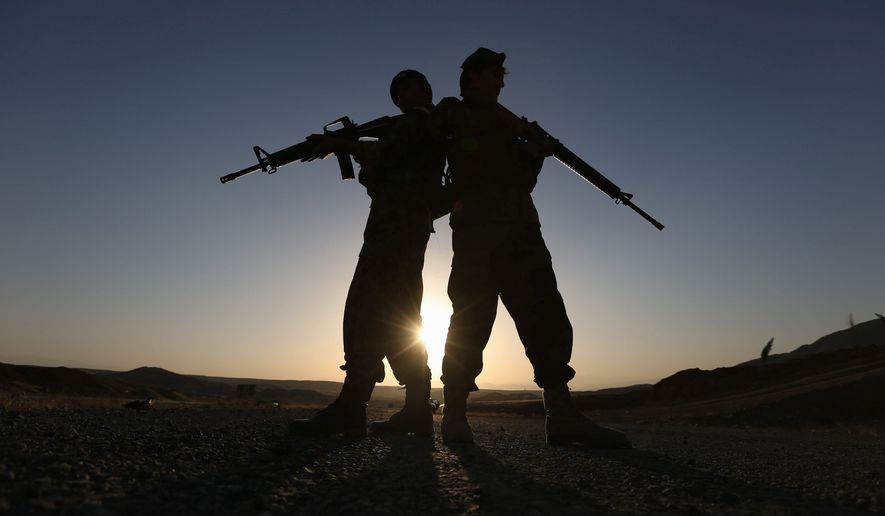Elite Army Green Berets are knocking the performance of the Afghan National Army, telling war tales of its soldiers hiding and quitting the fight.
The Green Beret criticisms, contained in a U.S. Central Command “friendly fire” investigative file, provide a window into the flaws of a national army more than a decade in the making.
The Special Forces soldiers gave poor marks to the institution that is supposed to keep Afghanistan’s democratically elected governments in power. The security force must rebuff an expected Taliban offensive, on its own, once all American troops leave after 2016.
The soldiers gave statements to investigators after going into battle June 8-9 in the Gaza Valley of Zabul province, northeast of Kandahar. The Green Berets told of Afghan soldiers refusing to fight and hiding among trees and behind a rock.
The Afghans had no ability to fight at night, a hallmark of American forces. Green Berets had to take the lead in clearing villages controlled by Taliban militants, even though the steady withdrawal of U.S. forces is at the stage where Afghans are supposed to be “on point” — that is, the first to engage the enemy.
The Green Beret’s A-Team leader, a captain, made several unflattering statements. Investigators were probing the mission’s end point, when a B-1B bomber mistakenly dropped two bombs on a “friendly” position, killing five American soldiers and the Afghan sergeant commander.
PHOTOS: Top 10 U.S. fighter jets
The captain said the operation got off to a rough start when the Afghan National Army provided fewer soldiers than requested.
“They do not always show up with the forces promised,” he said. “This was not ideal.”
After the insertion, “The detachment took point due to the ANA’s inability to move during periods of darkness,” the captain said.
At about the midpoint in village clearing, he said, “The ANA became stagnant and were hiding in the green zones,” swaths of forested areas in an otherwise desert valley.
Then the Afghan soldiers simply quit.
“The detachment recommended to the ANA [commander] to move positions and continue clearing further down the valley,” the Green Beret leader said. “The ANA claimed to have cleared the entire valley but our positions identified that they had cleared only half of the valley. According to the ANA [commander], that was as much clearance as they were going to conduct.”
PHOTOS: Elite U.S. Navy SEALs in action
The captain added: “The ANA went into the green zone and were ineffective. We were only able to clear about half of the valley because of this.”
After the bombs hit, the job became, first, to set up a security perimeter and then to recover remains. The grisly work became more difficult “due to ANA ineffectiveness,” the officer said.
Another Green Beret told of a conversation with Afghan soldiers: “I then told him that we needed to set up a security perimeter. They instead huddled behind a rock.”
Is such poor performance indicative of the ANA’s general level of competence?
The Washington Times asked an Army officer who has had tours of duty in Afghanistan. “When we leave, the ANA will scatter like leaves in a stiff breeze,” the officer said.
Retired Army Maj. Gen. Robert Scales, a decorated combatant in Vietnam, said the Green Berets are cutting through the public relations spin from the NATO command in Kabul.
“One issue is warfare by spin, which I find very aggravating,” Mr. Scales said.
“No one I know in private moments will say that we’re doing well in Afghanistan,” Mr. Scales said. “I think what you’re hearing from [special operations forces] is that it is world-famous for never following the narrative. They are going to come back and tell the truth.
“And the truth is the Afghans don’t believe American aid and assistance are going to last that long. And so the Afghans are willing to play this war out at their pace,” Mr. Scales said. “There are no illusions about the competence of the ANA. Zero.”
The Pentagon’s most recent progress report on Afghanistan in April said the Afghan National Army, first conceived in 2002, remains unable to sustain itself more than several days in the field.
“The ANA made impressive progress, and maintained its tactical overmatch over the insurgency,” the report said.
Yet, the 180,000-soldier army cannot perform complex operations, such as close air support.
When told of the Green Berets’ experiences, U.S. Central Command’s press office pointed to Gen. John F. Campbell’s remarks about the Afghan force at a Pentagon press conference Oct. 2.
“The military here, the Afghan security forces, are completely different than when I left Iraq, and they’re completely different than when I was here just a couple of years ago,” said the top NATO commander in Afghanistan. “They’ve taken on the security mission from last June of ’13. They had it mostly entirely by themselves for the summer of ’14. I think they’ve done very well, supporting both the elections and through some of the major events.”
Gen. Campbell added: “The Afghan military is the most respected institution in Afghanistan. Every poll taken in the last two years, they’re at the very, very top.”
• Rowan Scarborough can be reached at rscarborough@washingtontimes.com.




Please read our comment policy before commenting.